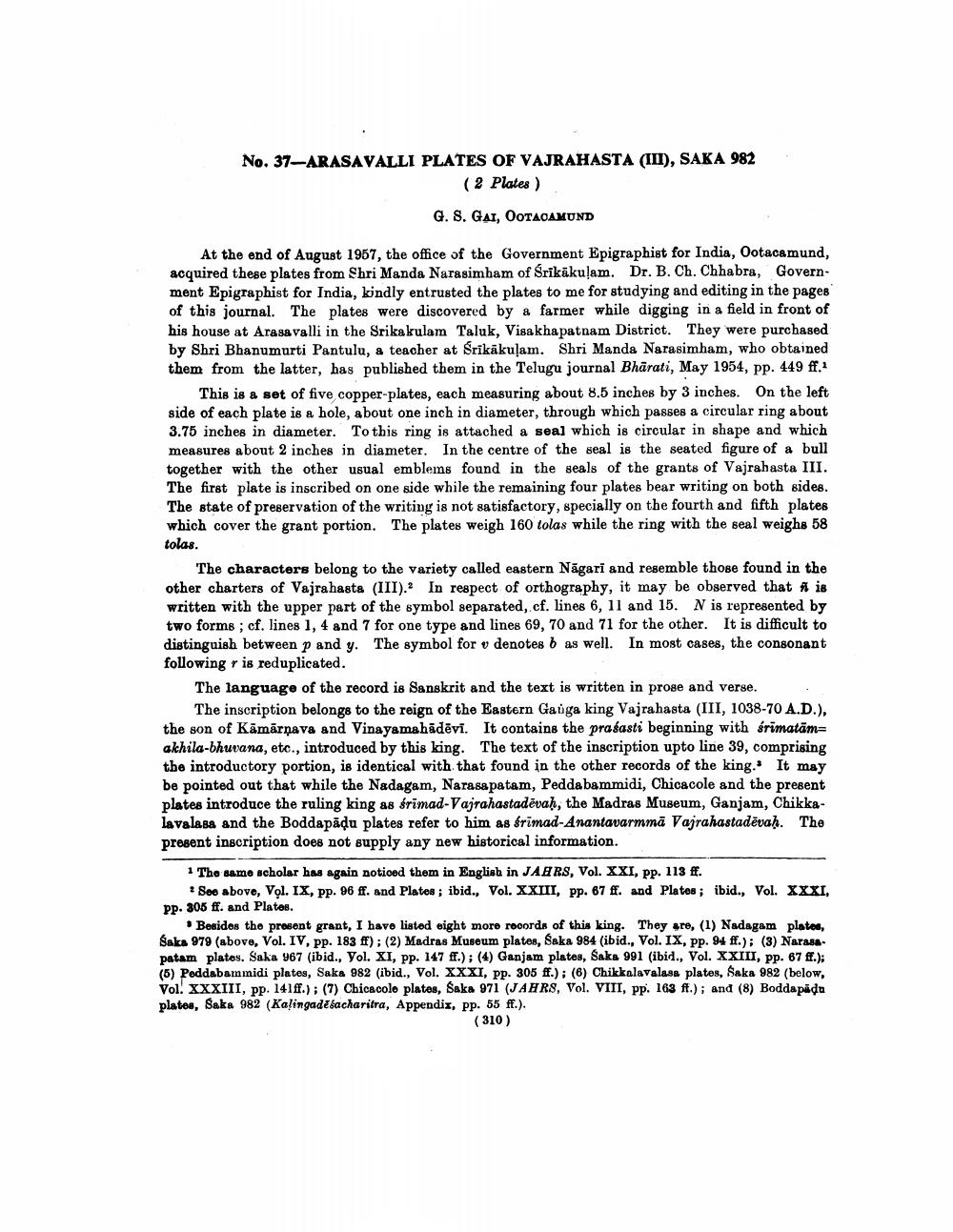________________
No. 37-ARASAVALLI PLATES OF VAJRAHASTA (III), SAKA 982 (2 Plates)
G. S. GAI, OOTACAMUND
At the end of August 1957, the office of the Government Epigraphist for India, Ootacamund, acquired these plates from Shri Manda Narasimham of Srikakulam. Dr. B. Ch. Chhabra, Government Epigraphist for India, kindly entrusted the plates to me for studying and editing in the pages of this journal. The plates were discovered by a farmer while digging in a field in front of his house at Arasavalli in the Srikakulam Taluk, Visakhapatnam District. They were purchased by Shri Bhanumurti Pantulu, a teacher at Srikakulam. Shri Manda Narasimham, who obtained them from the latter, has published them in the Telugu journal Bharati, May 1954, pp. 449 ff.1
This is a set of five copper-plates, each measuring about 8.5 inches by 3 inches. On the left side of each plate is a hole, about one inch in diameter, through which passes a circular ring about 3.75 inches in diameter. To this ring is attached a seal which is circular in shape and which measures about 2 inches in diameter. In the centre of the seal is the seated figure of a bull together with the other usual emblems found in the seals of the grants of Vajrahasta III. The first plate is inscribed on one side while the remaining four plates bear writing on both sides. The state of preservation of the writing is not satisfactory, specially on the fourth and fifth plates which cover the grant portion. The plates weigh 160 tolas while the ring with the seal weighs 58 tolas.
The characters belong to the variety called eastern Nagari and resemble those found in the other charters of Vajrahasta (III). In respect of orthography, it may be observed that is written with the upper part of the symbol separated, cf. lines 6, 11 and 15. N is represented by two forms; cf. lines 1, 4 and 7 for one type and lines 69, 70 and 71 for the other. It is difficult to distinguish between p and y. The symbol for v denotes b as well. In most cases, the consonant following r is reduplicated.
The language of the record is Sanskrit and the text is written in prose and verse.
The inscription belongs to the reign of the Eastern Gauga king Vajrahasta (III, 1038-70 A.D.), the son of Kāmārņava and Vinayamahādēvi. It contains the prasasti beginning with śrimatam= akhila-bhuvana, etc., introduced by this king. The text of the inscription upto line 39, comprising the introductory portion, is identical with that found in the other records of the king. It may be pointed out that while the Nadagam, Narasapatam, Peddabammidi, Chicacole and the present plates introduce the ruling king as śrimad-Vajrahastadevaḥ, the Madras Museum, Ganjam, Chikkalavalasa and the Boddapaḍu plates refer to him as śrimad-Anantavarmmā Vajrahastadevah. The present inscription does not supply any new historical information.
1 The same scholar has again noticed them in English in JAHRS, Vol. XXI, pp. 113 ff.
2 See above, Vol. IX, pp. 96 ff. and Plates; ibid., Vol. XXIII, pp. 67 ff. and Plates; ibid., Vol. XXXI, pp. 305 ff. and Plates.
Besides the present grant, I have listed eight more records of this king. They are, (1) Nadagam plates, Saka 979 (above, Vol. IV, pp. 183 ff); (2) Madras Museum plates, Saka 984 (ibid., Vol. IX, pp. 94 ff.); (3) Narasapatam plates. Saka 967 (ibid., Vol. XI, pp. 147 ff.); (4) Ganjam plates, Saka 991 (ibid., Vol. XXIII, pp. 67 ff.); (5) Peddabammidi plates, Saka 982 (ibid., Vol. XXXI, pp. 305 ff.); (6) Chikkalavalasa plates, Saka 982 (below, Vol. XXXIII, pp. 141ff.); (7) Chicacole plates, Saka 971 (JAHRS, Vol. VIII, pp. 163 ft.); and (8) Boddapādu plates, Saka 982 (Kalingadesacharitra, Appendix, pp. 55 ff.).
(310)




